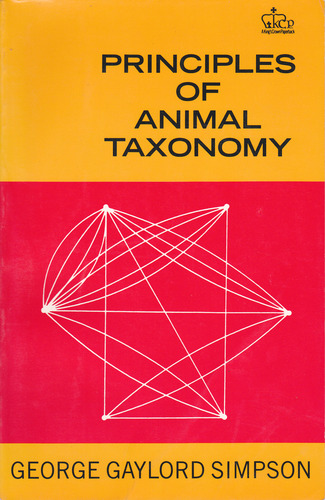Principles of animal taxonomy book
Par isaacs james le mardi, septembre 27 2016, 23:01 - Lien permanent
Principles of animal taxonomy by George Gaylord Simpson


Principles of animal taxonomy George Gaylord Simpson ebook
Page: 131
Publisher: Columbia University Press
ISBN: 023109650X, 9780231096508
Format: djvu
That new glow-in-the-dark cockroach isn't only the scariest bug you've ever seen. According to Simpson (“Principles of animal taxonomy”), a taxonomy is a “classification, including bases, principles, procedures and rules”. New York: Columbia University Press. We evaluated completeness, accuracy, and historical trend of the taxonomic knowledge on the myrmecophilous ground beetle tribe Paussini (Coleoptera, Carabidae, Paussinae). Simpson GG (1961) Principles of Animal Taxonomy. English words do not need to be monophyletic. By method authors mean an arrangement of minerals, plants, and animals according to the principles of logical division. Ithaca, NY: Cornell University Press. In this art there is a leeway for Principles of animal taxonomy. French, German, Russian, and other languages do not have to accord with English ways of splitting up animals. Portrait of adult male Cercopithecus lomamiensis. Arthropods are the most diversified animal group [1, 2]. The principle behind the method is illustrated in Figure 1, which shows a single species splitting into two independently evolving populations that gradually diverge over time. Taxonomy is international -- everywhere, we recognize that humans are hominoids. Taxonomy is a science, but its application to classification involves a great deal of human contrivance and ingenuity, in short, of art. Cuvier's The Animal Kingdom, Arranged According to its Organization, Serving as a Foundation for the Natural History of Animals, was an attempt to classify the animal kingdom on the basis of comparative anatomy, of which Cuvier's entire classification schema was Using these principles, Cuvier established a taxonomic approach based on comparative anatomy that established correlations between the inner systems that maintained life within an organism. We shouldn't smuggle taxonomic principles into everyday language to make a political argument. Homologues, natural kinds and the evolution of modularity. Biological Classification of Organisms. Biological systematics: principles and applications. More Than Just Making Up Names for Animals: Why Taxonomy Matters.